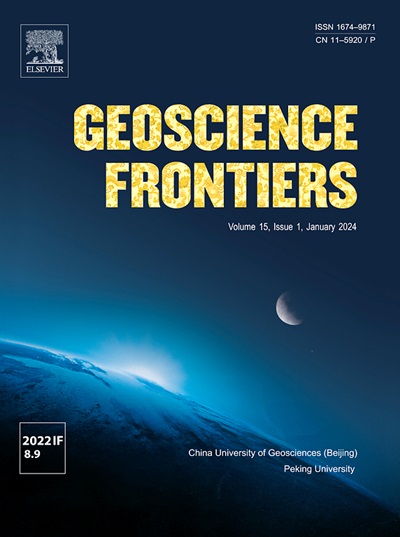弧后崩塌引发的暖大陆俯冲:来自偏远的塔斯马尼亚西南部的证据
IF 8.5
1区 地球科学
Q1 GEOSCIENCES, MULTIDISCIPLINARY
引用次数: 0
摘要
塔斯马尼亚微大陆位于新元古代晚期和古生代早期的东冈瓦纳增生边缘,具有明确的高压变质记录,其中包含了关于该边缘俯冲地球动力学的关键信息。塔斯马尼亚微大陆的俯冲被一些人解释为寒武纪泰南造山运动期间蛇绿岩逆冲和高压变质作用之前弧后盆地反转的反应。然而,从曾经位于俯冲大陆边缘的岩石中获得的支持这种模式的热气压证据是缺乏的。尽管在塔斯马尼亚西部强烈变形的Tyennan地区出现榴辉岩相矿物组合,但在遥远的塔斯马尼亚西南海岸的变质沉积岩岩性中记录的含石榴石的石英岩组合被解释为低压至中压变质作用的表现。我们报道了Tyennan地区南部(Nye湾)的一个强烈叠印绿泥石-石英-石榴石组合,显示了高压变质作用的证据。粗粒石榴石卟绿母岩含有蓝晶石、白云母和金红石包裹体,其原位Lu-Hf测年约为520 Ma。cm尺度的石榴石卟卟母细胞在主元素和微量元素上划分,保留了反映石榴石上压生长的岩心-边缘组成梯度。在矿物平衡正模拟的帮助下,寒武系金红石的石榴石边缘组成和Zr含量限制了~ 17.5 ~ 19 kbar和~ 780 ~ 820℃的峰值变质条件,相当于410 ~ 470℃/GPa的暖俯冲热梯度。石榴石岩心组成和石英包裹体的Ti含量限制了石榴石成核的压力和温度在~ 6 ~ 7 kbar和~ 560 ~ 580℃,对应于800 ~ 965℃/GPa之间较高的梯度梯度。根据西南塔斯马尼亚变质记录确定的热梯度,为寒武系俯冲系统热状态的渐进演化提供了一个直接的窗口,石榴石成核的物理条件可能反映了俯冲起始的物理条件。相应的温热梯度为造山前弧后塌陷驱动的俯冲起始提供了证据。这一解释与现有的泰南造山构造模型一致,该模型提出了塔斯马尼亚西部亚蛇绿变质底原岩的弧后盆地起源。本文章由计算机程序翻译,如有差异,请以英文原文为准。

Warm continental subduction initiated by back-arc collapse: Evidence from remote south-west Tasmania
The Tasmanian microcontinent, situated along the East Gondwana accretionary margin during the late Neoproterozoic and early Palaeozoic, contains an unequivocal high-pressure metamorphic record comprising key information pertaining to the geodynamics of subduction along the margin. Subduction of the Tasmanian microcontinent is interpreted by some as a response to back-arc basin inversion prior to ophiolite obduction and high-pressure metamorphism during the Cambrian Tyennan Orogeny. However, thermobarometric evidence in support of such a model from rocks once positioned on the subducting continental margin is lacking. Despite occurrences of eclogite-facies mineral assemblages in the strongly deformed Tyennan Region of western Tasmania, garnet-bearing quartzofeldspathic assemblages documented in metasedimentary lithologies from the remote south-west coast of Tasmania have been interpreted as an expression of low- to moderate-pressure metamorphism. We report a strongly overprinted chlorite-quartz-garnet-bearing assemblage from the southern Tyennan Region (Nye Bay) which shows evidence for high-pressure metamorphism. Coarse-grained garnet porphyroblasts contain inclusions of kyanite, muscovite, and rutile, and yield in-situ Lu–Hf dates of c. 520 Ma. The cm-scale garnet porphyroblasts are zoned in the major and trace elements, preserving core-rim compositional gradients reflecting garnet growth up-pressure. Aided by mineral equilibria forward modelling, the garnet rim compositions and the Zr content of Cambrian rutile constrain peak metamorphic conditions of ∼ 17.5–19 kbar and ∼ 780–820 °C, equivalent to warm subduction thermal gradients between 410–470 °C/GPa. Garnet core compositions and the Ti content of quartz inclusions in the garnet cores constrain the pressures and temperatures for garnet nucleation to ∼ 6–7 kbar and ∼ 560–580 °C, corresponding to relatively high prograde thermal gradients between 800–965 °C/GPa. The thermal gradients determined from the south-west Tasmanian metamorphic record provide a direct window into the progressive evolution of the thermal state of the Cambrian subduction system, with the physical conditions of garnet nucleation potentially reflecting those of subduction initiation. The corresponding warm thermal gradients provide evidence for subduction initiation driven by the collapse of a pre-orogenic back-arc. This interpretation is consistent with an existing tectonic model for the Tyennan Orogeny which proposes a back-arc basin origin for the protoliths to the western Tasmanian sub-ophiolitic metamorphic sole.
求助全文
通过发布文献求助,成功后即可免费获取论文全文。
去求助
来源期刊

Geoscience frontiers
Earth and Planetary Sciences-General Earth and Planetary Sciences
CiteScore
17.80
自引率
3.40%
发文量
147
审稿时长
35 days
期刊介绍:
Geoscience Frontiers (GSF) is the Journal of China University of Geosciences (Beijing) and Peking University. It publishes peer-reviewed research articles and reviews in interdisciplinary fields of Earth and Planetary Sciences. GSF covers various research areas including petrology and geochemistry, lithospheric architecture and mantle dynamics, global tectonics, economic geology and fuel exploration, geophysics, stratigraphy and paleontology, environmental and engineering geology, astrogeology, and the nexus of resources-energy-emissions-climate under Sustainable Development Goals. The journal aims to bridge innovative, provocative, and challenging concepts and models in these fields, providing insights on correlations and evolution.
 求助内容:
求助内容: 应助结果提醒方式:
应助结果提醒方式:


